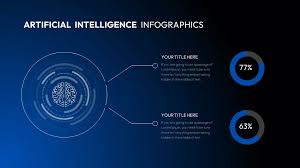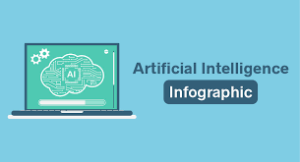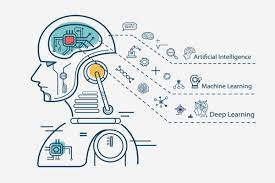Artificial intelligence infographics have indeed unlocked new opportunities for designers, offering automation and assistance in various design processes. AI infographic generators and platforms like Canva and Visma provide designers with the ability to generate multiple design alternatives quickly based on a few parameters or preferences.
AI is increasingly acting as a creative collaborator, helping designers explore new ideas, generate design variations, and streamline their workflows. By leveraging AI, designers can focus more on the conceptualization and strategic aspects of their work, while relying on AI to handle repetitive tasks and generate design options.
Artificial Intelligence Infographic
AI infographics can present information in a visually engaging manner, allowing readers to comprehend and remember the information more effectively. Looking ahead, the future of AI infographic illustration is likely to be shaped by technological advancements such as self-learning AI algorithms and the integration of augmented and virtual realities, enhancing the interactive and immersive experience for users.

AI Infographics Future
The human brain relies heavily on vision for perceiving and understanding the world. A significant portion of the brain is dedicated to visual processing. People’s affinity for images is linked to their cognitive processes and attention span. Images, including Artificial intelligence infographics, are more attention-grabbing compared to plain blocks of text.
Cloud computing provides companies with the ability to access and analyze data in real-time from various sources, utilizing data storage, servers, databases, networking, and software over the Internet. Services like Azure and Google Cloud are examples of cloud computing platforms.
This real-time access to data allows companies to gain a clearer understanding of their current business operations and enables them to react swiftly. Moreover, the availability of more accurate and larger volumes of real-time data can significantly contribute to the creation of more comprehensive and up-to-date infographics, enhancing the depth and relevance of the visual representations.
Increased Use of AI Image Generation Software
Innovative AI systems like Jasper Art and DALL-E 2 utilize machine learning to generate images based on text descriptions. This technology allows AI to understand the meaning of words and convert them into unique visual representations. As a result, AI-powered infographic design can benefit from this software by enabling users to quickly generate custom art based on their specific parameters, replacing the need for labor-intensive processes like searching for stock photos or manual editing.
More Impressive Images for Infographics
AI-based image enhancement tools like Vance AI and Upscalepics are designed to simplify the process of restoring and improving picture quality. These tools utilize AI algorithms to enhance pixelated or blurry images, making them high-quality, clean, and sharp. They also offer quick fixes for issues like poor lighting, contrast, and color, often requiring just seconds to produce improved results.
Artificial Intelligence Infographics for Personalized Experience
Big data analysis plays a significant role in shaping the future of infographics. Designers are increasingly utilizing big data to understand customer preferences and optimize their infographic designs accordingly. By leveraging AI and analyzing large volumes of data, companies can better target their audience’s likes and dislikes. This enables the creation of personalized and tailored infographics that foster brand loyalty and forge stronger connections with customers.
AI Infographics Based on Speedier Predictive Forecasting
Designers and engineers are leveraging artificial intelligence to develop intelligent algorithms that can solve complex problems. AI enables the rapid generation of millions of design variations, making the design process more efficient. Through data analysis and predictive forecasting, AI can estimate future events based on historical data, providing valuable insights for decision-making and planning. AI will help in rapidly analyzing extensive data sets and proposing design adjustments for infographics, which designers can approve based on the data.
Infographic Design Based on Self-Learning AI Algorithms
Designers are increasingly using artificial intelligence infographic generators and techniques, such as deep reinforcement learning (deep RL), to train AI models and create infographics based on their preferences. Deep RL is a branch of machine learning and AI that enables intelligent machines to learn from their actions, similar to how humans learn from their experiences. By applying deep RL, AI systems can make creative decisions independently and improve their performance over time.
Top AI Infographic Generators

Artificial intelligence infographic generators can be valuable tools, depending on the specific needs and circumstances. Here are some factors to consider when evaluating the worth of AI infographic generators:








